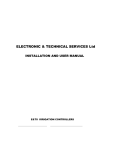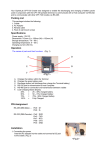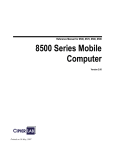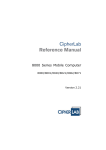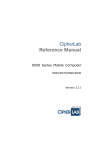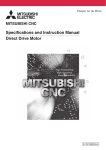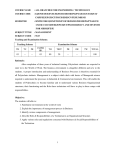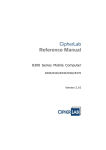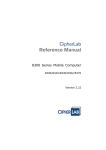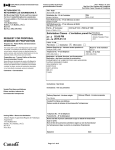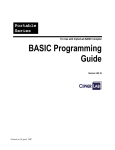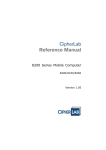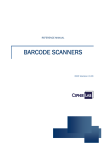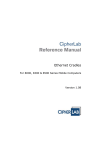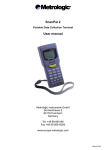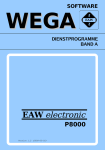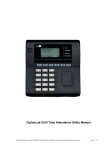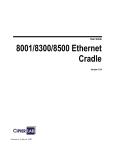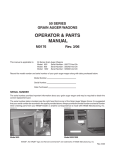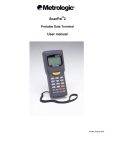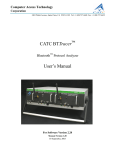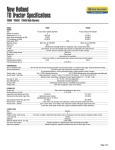Download 8000 Series
Transcript
Reference Manual for 8000, 8001, 8020, 8021, 8061, 8071 8000 Series Mobile Computer Version 2.00 Printed on 14 April, 2007 Copyright Notice Copyright © 2007 CIPHERLAB CO., LTD. All rights reserved The software contains proprietary information of CIPHERLAB CO., LTD.; it is provided under a license agreement containing restrictions on use and disclosure and is also protected by copyright law. Reverse engineering of the software is prohibited. Due to continued product development this information may change without notice. The information and intellectual property contained herein is confidential between CIPHERLAB and the client and remains the exclusive property of CIPHERLAB CO., LTD. If you find any problems in the documentation, please report them to us in writing. CIPHERLAB does not warrant that this document is error-free. No part of this publication may be reproduced, stored in a retrieval system, or transmitted in any form or by any means, electronic, mechanical, photocopying, recording or otherwise without the prior written permission of CIPHERLAB CO., LTD. For product consultancy and technical support, please contact your local sales representative. Also, you may visit our web site for more information. The CipherLab logo is a registered trademark of CIPHERLAB CO., LTD. CIPHERLAB CO., LTD. Website: http://www.cipherlab.com II FCC Regulations This equipment has been tested and found to comply with the limits for a Class B digital device, pursuant to Part 15 of the FCC Rules. These limits are designed to provide reasonable protection against harmful interference in a residential installation. This equipment generates, uses and can radiate radio frequency energy and, if not installed and used in accordance with the instructions, may cause harmful interference to radio communications. However, there is no guarantee that interference will not occur in a particular installation. If this equipment does cause harmful interference to radio or television reception, which can be determined by turning the equipment off and on, the user is encouraged to try to correct the interference by one or more of the following measures: Reorient or relocate the receiving antenna. Increase the separation between the equipment and receiver. Connect the equipment into an outlet on a circuit different from that to which the receiver is connected. Consult the dealer or an experienced radio/TV technician for help. Important Safety Precautions RISK OF EXPLOSION IF BATTERY IS REPLACED BY AN INCORRECT TYPE DISPOSE OF USED BATTERIES ACCORDING TO THE INSTRUCTIONS The use of any batteries or charging devices, which are not originally sold or manufactured by CipherLab, will void your warranty and may cause damage to human body or the product itself. The charging and communication cradle uses an AC power adaptor. A socket outlet shall be installed near the equipment and shall be easily accessible. The power adaptor should comply with L.P.S test. Make sure there is stable power supply for the mobile computer or its peripherals to operate properly. DO NOT disassemble, incinerate or short circuit the battery pack. DO NOT expose the mobile computer or the battery pack to any flammable sources. Under no circumstances, internal components are self-serviceable. Per FDA and IEC standards, the scan engines described in this manual are not given a laser classification. However, the following precautions should be observed: CAUTION This laser component emits FDA/IEC Class 2 laser light at the exit port. Do not stare into beam. III Care & Maintenance The 8000 Series is intended for enterprise logistics use, however, it may do damage to the mobile computer when being exposed to high temperatures or soaked wet. When the body of the mobile computer gets dirty, use a clean and wet cloth to wipe off the dust. DO NOT use/mix any bleach or cleaner. Always keep the LCD dry. For a liquid crystal display (LCD), use a clean, non-abrasive, lint-free cloth to wipe dust off the screen. DO NOT use any pointed or sharp object to move against the surface. Battery disposal – For green-environment issue, it is important that batteries should be recycled in a proper way. If you want to put away the mobile computer for a period of time, download the collected data to a host computer, and then take out the battery pack. Store the mobile computer and battery pack separately. When the mobile computer resumes its work, the main and backup batteries will take a certain time to become fully charged. If you shall find the mobile computer malfunctioning, refer to the Troubleshooting section for self help first. If the problem persists, write down the specific scenario and consult your local sales representative. Getting Started Below are instructions of how to have the 8000 Series ready to work. This scenario makes use of a cradle, which may be replaced by the 4-slot battery charger or other specified interface to PC. Set up the cradle for initial charging. Install the battery pack to the mobile computer, and then seat the mobile computer in the cradle for charging. When charging is done, turn on the mobile computer and enter the System Menu for system configuration, downloading programs and font file, and so on. Before downloading, you must connect a serial cable between the cradle and a host computer. Refer to the System Menu > 6. Load Program for more information. After charging and downloading, the mobile computer is ready for use. Install the hand strap if necessary. IV i Contents Copyright Notice II FCC Regulations III Important Safety Precautions III Care & Maintenance IV Getting Started IV Preface 1 Revision History ...........................................................................................................................................1 CHAPTER 1 - Introduction 3 1.1 Inside the Package ..................................................................................................................................3 1.2 Options....................................................................................................................................................4 1.3 Product Highlights ..................................................................................................................................4 1.4 Overview.................................................................................................................................................5 1.4.1 Nomenclature ...........................................................................................................................5 1.4.2 Dimensions ...............................................................................................................................7 1.5 Features...................................................................................................................................................8 1.5.1 Power........................................................................................................................................8 1.5.2 CPU ..........................................................................................................................................9 1.5.3 Memory ....................................................................................................................................9 1.5.4 Keypad....................................................................................................................................10 1.5.5 LCD ........................................................................................................................................12 1.5.6 Status LED..............................................................................................................................13 1.5.7 Buzzer.....................................................................................................................................13 1.5.8 Reader.....................................................................................................................................13 1.5.9 Wireless Support ....................................................................................................................15 1.5.9 Impact Resistance ...................................................................................................................17 1.5.10 Application Software............................................................................................................17 1.5.11 Programming Support...........................................................................................................17 ii Contents CHAPTER 2 - Installation 19 2.1 Installing the Battery Pack ....................................................................................................................19 2.2 Setting up the Cradle.............................................................................................................................20 CHAPTER 3 - Software Architecture 21 3.1 Overview...............................................................................................................................................21 3.2 System Configuration ...........................................................................................................................22 3.3 Application Programs ...........................................................................................................................23 3.3.1 Application Generator (AG) ...................................................................................................23 3.3.2 CipherNet ...............................................................................................................................23 3.3.3 User Program..........................................................................................................................24 CHAPTER 4 - Configuration 25 4.1 System Menu ........................................................................................................................................26 4.1.1 Information .............................................................................................................................26 4.1.2 Settings ...................................................................................................................................28 4.1.3 Tests........................................................................................................................................30 4.1.4 Memory ..................................................................................................................................32 4.1.5 Power......................................................................................................................................33 4.1.6 Load Program .........................................................................................................................34 4.1.7 (1) Serial PPP Menu ...............................................................................................................35 4.1.7 (2) IR Network Menu (Ethernet via IR) .................................................................................39 4.1.7 (3) Bluetooth Menu – for 8061...............................................................................................42 4.1.7 (4) Wi-Fi Menu – for 8071 .....................................................................................................52 4.2 Program Manager .................................................................................................................................60 4.2.1 Download ...............................................................................................................................60 4.2.2 Activate ..................................................................................................................................63 4.2.3 Upload ....................................................................................................................................64 4.3 Kernel Menu .........................................................................................................................................65 4.3.1 Kernel Information .................................................................................................................65 4.3.2 Load Program .........................................................................................................................66 4.3.3 Kernel Update.........................................................................................................................68 4.3.4 Test & Calibrate .....................................................................................................................69 4.3.5 Bluetooth Menu ......................................................................................................................70 Specifications 71 Troubleshooting 73 APPENDIX I - Download Utilities 77 ProgLoad.exe ..............................................................................................................................................78 Communication Type ......................................................................................................................78 File Type..........................................................................................................................................78 IRLoad.exe .................................................................................................................................................79 Command Line ................................................................................................................................79 Contents iii Download.exe .............................................................................................................................................80 Command Line ................................................................................................................................80 iv Contents Table of Figures Figure 1: Nomenclature (front & back) .....................................................................................6 Figure 2: Dimensions ...................................................................................................................7 Figure 3: Keypad layout ............................................................................................................10 Figure 4: Installing the Battery Pack .......................................................................................19 Figure 5: Setting up the Cradle.................................................................................................20 Figure 6: Software Architecture ...............................................................................................21 1 Preface Answering light industrial demands, the 8000 Series Mobile Computer is specifically designed for enterprise logistics use. Small-form-factor and light-weight, it proves to be an ace player in retail and healthcare applications. This line of product comes with optional Bluetooth and 802.11b/g wireless technologies, enabling real time sharing of performance. The 8000 Series is bundled with powerful and rich features to ensure success in timely processing of information, and thus, makes an ideal choice for inventory control, shop floor management, warehousing and distribution operations. Being programmable, this handy device can run custom applications or terminal emulation applications. This manual serves to guide you through how to install, configure, and operate the mobile computer. We recommend you to keep one copy of the manual at hand for quick reference or maintenance purposes. To avoid any improper disposal or operation, please read the manual thoroughly before use. Thank you for choosing CipherLab products! Revision History Version Release Date Notes 2.00 Apr. 14, 2007 New release 2 8000 Series Reference Manual 3 CHAPTER 1 Introduction This chapter mainly explains the hardware parts and features of the 8000 Series Mobile Computer. The 8000 family includes: 8000 Batch type (powered by two AAA alkaline batteries) 8001 Batch type (powered by Li-ion battery) 8020 Acoustic Coupler (powered by two AAA alkaline batteries) 8021 Acoustic Coupler (powered by Li-ion battery) 8061 Bluetooth Class 1 (powered by Li-ion battery) 8071 802.11b/g (powered by Li-ion battery) In This Chapter 1.1 Inside the Package ....................................................... 3 1.2 Options......................................................................... 4 1.3 Product Highlights ....................................................... 4 1.4 Nomenclature............................................................... 5 1.5 Features........................................................................ 8 1.1 Inside the Package The following items are included in the package. Save the box and packaging material for future use in case you need to store or ship the mobile computer. Items Inside Package 8000 Rechargeable Li-ion battery − 8001 √ Wrist Strap √ Acoustic Coupler Belt 8020 8021 8061 8071 − √ √ √ √ − − √ √ − − √ √ − − Belt Clip − − − − − √ Software & Manual CD √ √ √ √ √ √ 4 8000 Series Reference Manual 1.2 Options Rich choices of optional accessories are available for you to enhance the total performance of the mobile computer. Spare rechargeable Li-ion battery 4-slot Battery Charger Communication Cradle USB Cradle Charging & Communication Cradle Modem Cradle Ethernet Cradle Bluetooth Access Point 802.11b/g Access Point 1.3 Product Highlights Ergonomic design – small-form-factor with hand strap for secure hold. Built light-weight to enhance mobility and ease data-intensive applications. Flexible wireless solution - connectivity options includes Bluetooth or 802.11b/g. Acoustic Coupler for US market, ideal for replacement of older style terminals. Graphic monochrome LCD supports double-byte characters and bitmap graphics. Programmable feedback includes buzzer and LED indicator. Quick link to any backend database through Windows-based CipherNet programs for VT100/220 and IBM 5250 emulation. Easy customization of AG applications through Windows-based Application Generator (AG) programs for preloaded AG Runtime. Programming support includes BASIC & C compilers. Chapter 1 Introduction 1.4 Overview 1.4.1 Nomenclature 5 6 8000 Series Reference Manual Figure 1: Nomenclature (front & back) Chapter 1 Introduction 1.4.2 Dimensions Below shows the dimensions of Model 8000. Figure 2: Dimensions 7 8 8000 Series Reference Manual 1.5 Features 1.5.1 Power Main Battery Except that Model 8000/8020 is powered by two AAA alkaline batteries, Model 8001/8021/8061/8071 is powered by a rechargeable 3.7 V/700 mAh Li-ion battery pack, and it takes approximately two hours to fully charge it. For power-saving purpose, always turn off the backlight while working in a well-lit area. When the backlight is on for extended periods of time, the main battery will become low sooner than expected. The smart battery icon on the LCD screen shows the status of power consumption. There are two ways to monitor a low battery charge or discharged battery from the screen. Examine the level of the battery icon Monitor voltage level (see section 4.1.5 Power) Backup Battery In addition, one 3.0 V/7 mAh rechargeable Lithium button cell on the main board retains data in SRAM and maintains the running of the real-time clock and calendar. It takes at least twenty-four hours to fully charge the backup battery. For a fully charged backup battery, it can last for at least 30 days. However, it is not necessary to fully charge the backup battery for the mobile computer to work. Monitor voltage level (see section 4.1.5 Power) Initial Charging The rechargeable battery pack must be fully charged before using the mobile computer for the first time. Because the internal backup battery is constantly charged from the main battery, the initial charging requires installing the battery pack to the mobile computer and then seating the mobile computer in the cradle for charging. This will have both the main and backup batteries charged at the same time. Note: For initial charging, it takes approximately 2 hours to fully charge the main battery. Chapter 1 Introduction 9 Caution of Low Battery Charge The power source for the 8000 Series to work can be alkaline batteries (2*AAA for Model 8000/8020) or the rechargeable battery pack (for Model 8001/8021/8061/8071). The alkaline batteries or the battery pack charges the backup battery on the main board so that the data stored in SRAM can be retained properly. Therefore, when the main battery charge goes low, you must replace the alkaline batteries or the battery pack. For Model 8001/8021/8061/8071, you can charge it in the cradle as soon as possible. Always remember to save data before it is too late! Warning: Data loss may occur with SRAM during low battery condition. Always save data before running out of power or keep a fresh battery or batteries for replacement. 1.5.2 CPU A 16-bit CMOS type CPU is utilized, low power consumption. 1.5.3 Memory The collected data can be sent back to a host computer immediately or stored in memory (SRAM). Program Memory 2 megabytes flash memory for core, OS, application programs, font, etc. Data Memory 2 megabytes SRAM with contents backup by a 7 mAh rechargeable Lithium button cell. Calendar A calendar chip is equipped for accurate time/date logging. Caution of Data Loss When the main battery or batteries are removed or drained, the backup battery on the main board is to retain the contents of SRAM and maintain the running of the calendar for at least 30 days, on condition that the backup battery has already been fully charged. 10 8000 Series Reference Manual If you want to put away the mobile computer for a couple of days, you should be aware that data loss occurs when both the main and backup batteries discharge completely. Therefore, it is necessary to save data in a host computer before putting away the mobile computer! 1.5.4 Keypad The mobile computer can be equipped with a keypad of 21 keys for system setup, user entry and so on. The keypad comes with programmable LED backlight, like the screen. Silicon rubber has been chosen for their durability and prompt feedback. The key click can be configured through programming or the System Menu. It consists of the following keys: One scan button (the yellow one at top) Two [ENTER] keys (the blue ones next to the scan button) Two arrow keys for moving the cursor up or down, an alphanumeric keypad and assorted characters. One [POWER] key (the red one at bottom) By default, it is set to numeric mode. Press the [ALPHA/FN] key to enter alpha mode, capital or small letters. Figure 3: Keypad layout Chapter 1 Introduction 11 Alpha/FN Key This special function key is used to toggle among different input modes and the function mode. The icon will appear on the lower-right corner of the device screen. Status Icon Alpha/FN Key Input/Function Mode None N/A Numbers “A” Press [Alpha/FN] key one time Capital letters “a” Press [Alpha/FN] key two times Small letters “F” Press [Alpha/FN] key three times Function Mode Note: It is not necessary to hold down the [Alpha/FN] key. Input Mode This alphanumeric keypad is set to numeric mode by default. The Alpha key serves as a toggle among numeric, alpha (lower-case alphabetic), and ALPHA (upper-case alphabetic) modes. When using the 24-key keypad, each numeric key can be used to generate one of the three letters. For example, the numeric key [2] can be used to produce the letter [A], [B] or [C]. When you press the same key without halting longer than one second, the three letters will be displayed in a circulating way. Only when you stop pressing the key or hold it for more than one second or press another key, will the system send the real key code to the application program. Function Mode The [ALPHA/FN] (function) key serves as a modifier key. When you press a set of function keys, the system will send the associated key codes to the application program, and it is up to the application program to interpret the key codes. 1. To enable this modifier key, press [FN] on the keypad. An italic "F" will appear on the lower-right corner of the device screen. This modifier key is hold down as long as the icon is displayed. 2. Now press another key to get the value of key combination (say, press [1] to get the value of F1). The icon will go off now. 3. To get the value of another key combination modified by the [FN] key, repeat the above steps. To abort the key modification, press [FN] again, and the icon will go off. 12 8000 Series Reference Manual The functionality of each key combination is application-dependent. Below is a list of the factory setting for a variety of key combinations. Press and hold [FN], and then, press one of the following keys for a specific function: Key Combination Action [ENTER] Toggle ON/OFF the backlight of LCD and keypad at the same time [UP] Adjust LCD to high contrast [DOWN] Adjust LCD to low contrast 1.5.5 LCD The mobile computer comes with a FSTN graphic LCD, 100 by 64 pixels resolutions, which can be programmed to display text or graphics, such as specific font and company logo, to meet varying application needs. Options Font Size (pixels) Characters by lines English font Font size 6×8 (pixels) 16 characters by 8 lines Font size 8×16 (pixels) 12 characters by 4 lines Chinese font Font size 16×16 (pixels) 7 characters by 4 lines Other language fonts, company logo… Programmable Note: Normally, the last column (ICON_ZONE) is reserved to display status icons, such as the battery icon. The backlight of screen and keypad helps ease reading under dim environments. Relevant settings can be configured or adjusted by pressing the following key combinations: Settings Key Combination Backlight ON/OFF [FN] + [Enter] LCD Contrast [FN] + [Up] or [FN] + [Down] Chapter 1 Introduction 13 1.5.6 Status LED The dual-color LED above the [Scan] trigger can be programmed to provide information that helps diagnosing. For example, if you are using AG Runtime, you will be informed of the scanning result immediately by this LED indicator: Red LED Green LED - Good Read - Error 1.5.7 Buzzer The buzzer is a low power transducer type and can be programmed for status feedback. Its pitch and duration are software programmable. 1.5.8 Reader Options of 1D scan engines are available for delivering flexibility to meet different requirements. CCD scan engine (Long Range Imager) Standard Laser scan engine Symbologies Supported & Enabled The supported symbologies depend on the scan engine you use; some of the supported symbologies must be enabled through programming if not enabled by default. CCD / Laser scan engine Symbologies (Also Known As) Enabled by default Codabar (NW7) Yes Industrial 25 Yes Interleaved 25 Yes Matrix 25 No Code 39 Yes 14 8000 Series Reference Manual Italian Pharmacode CIP 39 No (French Pharmacode) No Code 93 Yes Code 128 Yes EAN-128 Yes MSI No Plessey No RSS-14 No Telepen No EAN-8 Yes EAN-8 with Addon 2, Addon 5 Yes EAN-13 Yes EAN-13 with Addon 2, Addon 5 Yes GTIN No UPC-A Yes UPC-A with Addon 2, Addon 5 Yes UPC-E0/UPC-E1 Yes UPC-E0/UPC-E1 with Addon 2, Addon 5 Yes Chapter 1 Introduction 15 1.5.9 Wireless Support The 8000 Series supports state-of-the-art wireless technologies so that it can send / receive data in real time in an efficient way. WPAN: Infrared (IR / IrDA) technology for data exchange, embedded WPAN: Bluetooth technology for cable replacement & data exchange (8061) WLAN: IEEE 802.11b/g for wireless networking (8071) IR / IrDA The mobile computer has an integrated IR port on the bottom, which can directly establish connection with an IR device for printing or data exchange. Simply have the IR port of the mobile computer toward the IR port of the target device. This IR port supports CipherLab proprietary IR communication protocol and standard IrDA protocol. IrDA specification defines communications (transmit/receive data) between two IrDA enabled devices within a short range, line-of-sight. IR / IrDA Specifications Infra Red: Optical Data Rate: Up to 115200 bps Connected devices: Peer-to-Peer Coverage: From contact to 30 cm, line-of-sight Standard: CipherLab proprietary protocol and IrDA 1.0 Bluetooth Bluetooth technology is for cable replacement & data exchange. Model 8061 can directly communicate with any Bluetooth enabled device, not necessarily line-of-sight. Serial Port Profile (SPP) is for ad hoc networking, without going through any access point. Personal Area Networking Profile (PAN) makes use of Bluetooth Network Encapsulation Protocol (BNEP) for IP networking over Bluetooth. Access points (AP) are required. Dial-Up Networking Profile (DUN) makes use of a Bluetooth modem or mobile phone as a wireless modem. Also, it can be used to activate the GPRS functionality on a mobile phone. 16 8000 Series Reference Manual Bluetooth Specification Frequency Range: 2.4 GHz Data Rate: 433 kbps Connected Devices: 1 for DUN mode Up to 7 for SPP or PAN mode (AP required) Profiles: SPP, PAN, DUN Coverage: Class 1 – 250 meters line-of-sight Max. Output Power: Class 1 – 16 mW Spread Spectrum: FHSS Modulation: GFSK Standard: Bluetooth version 1.1 IEEE 802.11b/g Model 8071 can easily connect to legacy networks through access points (APs). Roaming among different networks is possible. IEEE 802.11b/g is an industrial standard for Wireless Local Area Networking (WLAN), which enables wireless communications over a long distance. The speed of connection between two wireless devices will vary with range and signal quality. To maintain a reliable connection, the data rate of the 802.11b/g system will automatically fallback as range increases or signal quality decreases. 802.11b/g Specification Frequency Range: 2.4 GHz Data Rate: 802.11b – 1, 2, 5.5, 11 Mbps 802.11g – 6, 9, 12, 18, 24, 36, 48, 54 Mbps Connected Devices: 1 for ad-hoc mode (No AP) Multiple for infrastructure mode (AP required) Profiles: IP/TCP/UDP Coverage: 350 meters line-of-sight Max. Output Power: 50 mW (802.11b) Spread Spectrum: DSSS Modulation: 802.11b – DBPSK (1 Mbps), DQPSK (2 Mbps), CCK (5.5 & 11 Mbps) 802.11g – OFDM Standard: IEEE 802.11b/g, interoperable with Wi-Fi devices Chapter 1 Introduction 17 1.5.9 Impact Resistance The 8000 Series is proved to survive drop test by the following criteria: Surface Type Distance to Surface Drop Times Concrete 1.2 meters 5 drops per 6 sides 1.5.10 Application Software Application Generator (AG) For easy development of applications, the mobile computer ships with development tools on the CD-ROM. It includes Windows-based Application Generator programs, batch and WLAN, as well as relevant utilities. Terminal Emulation The mobile computer supports VT100/220 and IBM 5250 terminal emulation for accessing a backend database. The Windows-based CipherNet programs are available on the CD-ROM. 1.5.11 Programming Support For developing custom applications, CipherLab provides BASIC and C compliers through licensing. 18 8000 Series Reference Manual 19 CHAPTER 2 Installation The mobile computer is designed for portable use, and it almost requires no installation except installing the rechargeable battery pack (or the alkaline batteries for Model 8000/8020). Warning: Read Important Safety Precautions before installation. 2.1 Installing the Battery Pack Always prepare a spare battery pack, especially when you are on the road. To save power, turn off the backlight when you are working in a bright work area. 1. Hold the mobile computer face down in one hand. 2. Press the battery lid release and slide the battery lid. 3. Remove the battery lid by the other hand. 4. Slide the battery pack into the battery compartment at a proper angle (30°~45°) so that the contacts of the battery are pressed onto the protruding contacts inside the compartment. Make sure that the battery is snugly fit into the compartment. 5. Replace the battery lid and lock it firmly. Note: For a new battery, make sure it is fully charged before use. Figure 4: Installing the Battery Pack 20 8000 Series Reference Manual 2.2 Setting up the Cradle You may choose an appropriate cradle that best suits your needs. 1. Place the cradle on a flat and clean surface. 2. Insert the connecter of the power cord to the power jack on the back of the cradle. 3. Insert the plug of the power cord to a nearby power outlet. 4. The cradle is ready for charging. 5. Seat the mobile computer in the cradle. If the cradle is capable of data communications, you can establish a connection with a computer or remote host. Refer to the Installation Guide of your cradle. Figure 5: Setting up the Cradle Chapter 3 Software Architecture 21 CHAPTER 3 Software Architecture In This Chapter 3.1 Overview ..................................................................... 21 3.2 System Configuration .................................................. 22 3.3 Application Programs .................................................. 23 3.1 Overview The software inside the mobile computer consists of three modules: Kernel, System, and Application Program. Figure 6: Software Architecture 22 8000 Series Reference Manual 3.2 System Configuration For managing system configurations and multiple programs, each mobile computer comes with the System Menu, Kernel, and Program Manager. System Menu The System Menu is bundled with BASIC Runtime or user programs that are written in “C”. It is for system configuration, functionality testing, downloading font file and program. Kernel Kernel is the innermost core of the OS. It provides services for downloading the active application program or font file, updating the kernel or the active application program, and configuring Bluetooth settings. Program Manager The Program Manager is part of the kernel. You may download as many as seven application programs, or six programs plus one font file. Chapter 3 Software Architecture 23 3.3 Application Programs 3.3.1 Application Generator (AG) The mobile computer is preloaded with CipherLab application program, AG Runtime. When you turn on the mobile computer, it displays the Main Menu of AG application. Before using the mobile computer to collect data, you need to configure the application with the companion tool on your computer. This time-saving development tool helps create application templates on your computer. For details on the AG application, please refer to separate user manual. Application Generator AG Runtime Companion Tool on PC-End Batch AG U8000*.SHX AG8000N.exe RF AG U8061*.SHX AG8061RF.exe U8071*.SHX AG8071RF.exe Note: The Application Generator (AG) software package includes (1) a companion tool for quickly developing your application, i.e. AG or RF AG; (2) several associated utilities to make it versatile in use. 3.3.2 CipherNet Instead of Application Generator, you may download the terminal emulation program, i.e. CipherNet Runtime, to the mobile computer. Refer to section 4.1.6 Load Program. Then, run individual companion tool on your computer. For details on the CipherNet application, please refer to separate user manual. Terminal Emulation CipherNet Runtime Companion Tool on PC-End VT100/220 80xx-VT.SHX CipherNet-VT.exe IBM 5250 80xx-5250.SHX CipherNet-5250.exe 24 8000 Series Reference Manual 3.3.3 User Program You may need to develop your own application program in BASIC or C. For detailed information, please contact CipherLab Co., Ltd. 25 CHAPTER 4 Configuration This section mainly describes how to configure the 8000 Series Mobile Computer, regarding system configurations and program download. When a menu is displayed, you may select an item by either of the following ways: using the [UP] and [DOWN] keys to move the highlight bar pressing the number key that corresponds to the item number On each screen, the last column displays status icons, such as: The smart battery icon indicates the current power status. The input mode and function mode, which are controlled by the [ALPHA/FN] key separately. To return to a previous page or menu, you may press [ESC] or follow the on-screen instructions. In This Chapter 4.1 System Menu ............................................................... 26 4.2 Program Manager ........................................................ 60 4.3 Kernel Menu ................................................................ 65 26 8000 Series Reference Manual 4.1 System Menu The System Menu is generated by a powerful utility, which offers an interface for engineers (programmers or system integrator) to view system information, change the configuration parameters, download programs and run diagnostics. This menu is designed for engineering tests and maintenance ONLY. For this reason, the System Menu provides password protection to prevent unauthorized users from accidentally changing system settings. How to access the System Menu? 1. Turn off the mobile computer. 2. Press [7] + [9] + [Power]. Warning! The System Menu is NOT for the use of any end users. The system password helps ensure system safety and integrity. 4.1.1 Information Here provides important system information to help diagnose the system. System Menu > 1. Information H/W Hardware version (PCB) S/N A serial number assigned to the mobile computer M/D Manufacturing date KNL Kernel version LIB C library version BSC BASIC Run-time version, if a BASIC application is downloaded USR Application program version DEV 5-digit code for optional hardware configurations For example, 1410-0 indicates the 21-key mobile computer uses rechargeable Li-ion battery and is equipped with the CCD scan engine as well as the 802.11b/g module for wireless connectivity. Chapter 4 Configuration 27 Understanding Device Code Device Code Modular Component Types 1st digit Reader module 0= No reader 1= CCD scan engine 2= Laser scan engine 2nd digit Wireless module 0= No wireless module 4= 802.11b/g module (8071) 5= Bluetooth module (8061) 6= Acoustic coupler 3rd digit Battery type (8000/8001) 0= 2*AAA Alkaline batteries 1= Rechargeable Li-ion battery 4th digit Reserved 0 5th digit Keypad module 0= 21-key (8020/8021) 28 8000 Series Reference Manual 4.1.2 Settings You can change the default settings here. System Settings Default Values Clock blank Backlight Period 20 seconds CPU Speed Full Auto Off 10 minutes Power On Options Program Resume Key Click Tone 2 System Password Open access Font System font Default Set (Reset to default) Factory settings Settings > Clock Set date and time for Real Time Clock. Enter two digits for the year, i.e. 04 for 2004. Settings > Backlight Period Set the backlight duration for the keypad and LCD. Enter a value between 0 and 9999 (second). Settings > CPU Speed Set the desired CPU speed. Chapter 4 Configuration 29 Settings > Auto Off The mobile computer will be turned off automatically when no operation is taking place during a specified period of time. Enter a value between 0 and 999 (minute). Note: To disable this function, enter 0. Settings > Power On Mode Set the startup screen once the mobile computer is turned on: Resume: Start from the last session of program before the mobile computer is turned off. Restart: Fresh start from the first session of the program. Settings > Key Click The system will produce an audible signal when any key on the keypad is pressed. The current value is highlighted. Select a desired tone for the buzzer or mute it. Settings > System Password Set a password to control user access to the System Menu. The password can be up to eight alphanumeric characters. Note: The password is case-sensitive. To disable a previous password, enter blank on the "Input new password" and "Verify password" screens. Settings > Font Font version information can be viewed here. It displays System Font if there is no custom font file. If a multi-language font file is downloaded, you will be able to select a font from the list. Settings > Reset to Default Reset system settings to the default values, except for the reader settings. 30 8000 Series Reference Manual 4.1.3 Tests Here provides functional tests for key parts. Tests > Reader Test the reading performance of the scanner. Press [SCAN] to start. To stop and exit the test, press any key. Note: The supported symbologies depend on the scan engine you use, and some of them are not enabled by default. Tests > Buzzer Test the buzzer with different frequency/duration combinations. Press [Enter] to start. To stop and exit the test, press any key. Tests > LCD & LED Test the LCD display and LED indicator. Press [Enter] to start. To stop and exit the test, press any key. Tests > Keyboard Test the rubber keys. Press any key and its corresponding character will be shown on the screen. To stop and exit the test, press [ESC]. Chapter 4 Configuration 31 Tests > Memory Test the data memory (SRAM), and the results will be shown on the screen. To stop and exit the test, press [ESC]. Warning! The contents of the data memory (SRAM) will be wiped out after test. Tests > Echo Test After a physical connection is established properly, run the utility “Echo Test” on your computer and start this test on your mobile computer. Select a desired baud rate. To stop and exit the test, press [ESC]. IR (Cradle-IR): This echo test is to verify connectivity via IR between the mobile computer and any cradle. MODEM: This echo test is to verify connectivity via modem. A telephone line must be connected to the Modem Cradle. Note: For the Modem Cradle, any value other than 57600 bps (default) must be configured through the DIP switch on the IR control board. 32 8000 Series Reference Manual 4.1.4 Memory Here provides information and initialization function of the memory. Memory > Size information RAM (onboard SRAM for data memory) Flash (for program memory) Memory > Initialize Initialize the data memory (SRAM). Warning! The contents of the data memory (SRAM) will be wiped out after memory initialization. Chapter 4 Configuration 33 4.1.5 Power Here shows the current voltage consumption. Main (battery): It shows dynamic status of the battery pack, which is used as the main power source. Backup (battery): It shows dynamic status of the button cell, which is used to retain data in SRAM. Warning! Always examine the battery icon on the screen so that you will be alerted for a low battery condition. 34 8000 Series Reference Manual 4.1.6 Load Program Here you can access the Load Program service provided by the kernel which will take over the job, and therefore, you will not be able to return to the System Menu by pressing [ESC]. After downloading, restart the mobile computer to activate the new program. .SHX Program Download one of the following C program files and/or one font file: Program File AG Runtime (U*.shx) CipherNet Runtime (85xx-5250.shx, 85xx-VT.shx) BASIC Runtime* (BC*.shx) User program Font File Refer to the Font Files folder on CD-ROM. If you have downloaded a BASIC Runtime program, the next time you enter the Load Program submenu you will be able to select whether to download a C program (.SHX) or BASIC program (.SYN). Note: (1) The interface option for Bluetooth is only available on 8061. (2) “Load Basic” menu is only available after you have downloaded a BASIC Runtime program. Chapter 4 Configuration 35 4.1.7 (1) Serial PPP Menu PPP, short for Point-to-Point Protocol, is a method of connecting the mobile computer to the Internet over serial links. It sends TCP/IP packets to a server that connects to the Internet. Note: The version of IR control board on the modem cradle must be greater than SV3.01. This submenu is for establishing a PPP connection via the Modem Cradle. You must configure these parameters correctly. 36 8000 Series Reference Manual Serial PPP Menu > Information Information of library version can be viewed here. Serial PPP Menu > 1. Information LIB C library version for PPP BSC BASIC Run-time version, if a BASIC application is downloaded. Below are available libraries that support (1) PPP connection over serial links (2) Ethernet connection – Transparent mode. Model # External Libraries 8000 (batch) 80PPP.lib 8001 (batch) 80PPP.lib 8061 (Bluetooth) 80PPP.lib OR 80BNEP.lib 8071 (802.11b/g) 80PPP.lib OR 80WLAN.lib Chapter 4 Configuration 37 Serial PPP Menu > Connection Set Serial PPP Menu > 2. Connection Set 1. DialUp Number Enter the number provided by your ISP. 2. Login Name Enter the login name provided by your ISP. 3. Login Password Enter the login password provided by your ISP. 4. Baud Rate Select a desired baud rate. Note: By default, the baud rate is set to 57600 bps on the Modem Cradle. For any other value, such as 115200/38400/19200/9600, you must configure through the DIP switch on the IR control board. 38 8000 Series Reference Manual Serial PPP Menu > Echo Test This echo test is used for verifying connectivity via Point-to-Point Protocol. For the Modem Cradle, its physical connectivity can be verified in System Menu > Tests > Echo Test > IR or MODEM. Serial PPP Menu > 3. Echo Test Enter the IP address of a server with which a PPP connection is desired. Then, it will try to connect to the server. Note: After the “PPP via IR” connection is established properly, run the utility “Echo Test” on your computer (TCP/IP – Server), and then, start this test on your mobile computer. Chapter 4 Configuration 39 4.1.7 (2) IR Network Menu (Ethernet via IR) This submenu is for Ethernet connection via IR networking. You must configure these parameters correctly. Note: The Ethernet Cradle is required for establishing Ethernet connection via IR. IR Network Menu > Information Information of Ethernet network configuration can be viewed here. IR Network Menu > 1. Information DHCP DHCP server in use or not I IP address of the mobile computer M Subnet Mask G Default Gateway Note: For Transparent mode, refer to Serial PPP Menu for available libraries. 40 8000 Series Reference Manual IR Network Menu > Network Setting Set parameters for IP networking. IR Network Menu > 2. Network Setting 1. DHCP Options - Enable or Disable 2. SubNet Mask Enter a new Mask IP, if necessary. 3. Local IP Address Enter a new address for the mobile computer, if necessary. 4. Default Gateway Enter a new address for the default Gateway, if necessary. 5. DNS Server Enter a new address for the DNS server, if necessary. 6. Domain Name The domain name of the host is shown here when DHCP server is enabled. Note: Normally, DHCP is enabled and all of the settings can be obtained form the DHCP server. Chapter 4 Configuration 41 IR Network Menu > Echo Tests The Ethernet Cradle supports three working modes: Data Mode Modem Mode Transparent Mode These echo tests are used for verifying connectivity via the Ethernet Cradle. For details, refer to the Ethernet Cradle manual. IR Network Menu > 3. Echo Tests Set the Ethernet Cradle in Data mode. The mobile computer works as a 1. Data Mode client. . 2. Modem Mode Set the Ethernet Cradle in Modem mode. The mobile computer works as a client. 3. Transparent Mode 1. Client Mode - Set the mobile computer as a client. Enter the IP address of a server with which a connection is desired. 2. Server Mode - Set the mobile computer as a server that waits for other devices to connect to. Note: After the “Ethernet via IR” connection is established properly, run the utility “Echo Test” on your computer (TCP/IP – Server or Client), and then, start this test on your mobile computer. 42 8000 Series Reference Manual 4.1.7 (3) Bluetooth Menu – for 8061 This submenu is for the Bluetooth module to work with other Bluetooth enabled devices. You must configure these parameters correctly. Note: This submenu is generated only when the Bluetooth module is present. Bluetooth Settings Default Value Connect Setting SPP DUN PAN Items Need to Be Checked Local Name Model no. + Serial no. v v v Remote Name --- v v v Broadcast Me Enabled v v v Power Saving Enabled v v v BT-GPRS AP Name --- --- (v)* --- Authentication Disabled v v v PIN Code --- v v v DHCP Enabled --- --- v SubNet Mask 255.255.128.0 --- --- v Local IP Address 0.0.0.0 --- --- v Default Gateway 0.0.0.0 --- --- v DNS Server 0.0.0.0 --- --- v Domain Name --- --- --- v Security Network Setting Note: GPRS AP name is ONLY required for DUN-GPRS mode. Chapter 4 Configuration 43 Bluetooth Menu > Information Information of network configuration can be viewed here. Bluetooth Menu > 1. Information LIB C library version for Bluetooth (BNEP) MAC MAC ID of the Bluetooth module ID A name given to the mobile computer for identification. CTY By default, it is made up of model No. and the serial number. (Identical to 2. Connect Set > 1. Local Name) "Normal" means all 79 channels are available for frequency-hopping (There are bandwidth limitations for 2.4 GHz ISM band in some countries. For example, only 23 RF channels are defined instead of 79 RF channels in Japan, Spain and France.) DHCP DHCP server in use or not IP IP address of the mobile computer Mask Subnet Mask Gate Default Gateway 44 8000 Series Reference Manual Bluetooth Menu > Connect Setting A basic Bluetooth system can be configured as (1) point to point - DUN mode, and (2) point to multi-point - SPP or PAN mode. Set the following parameters if necessary. Bluetooth Menu > 2. Connect Set 1. Local Name Enter a name for identifying the mobile computer. 2. Remote Name 3. Broadcast Me 4. Power Saving By default, it is made up of model No. and the serial number. Enter a name for making a specific connection. The remote name must be one of those in the Freq. Dev. List. Otherwise, the mobile computer will fail to make a connection with any device without pairing. DO NOT specify any remote name when roaming across different groups of APs is required. Options - Enable or Disable For initial connection, broadcasting must be enabled so that other Bluetooth devices can discover the mobile computer. For security concerns, you may disable it in future use to hide the mobile computer from other Bluetooth devices. This refers to the low power consumption mode. Options - Enable or Disable (Only the Sniff mode is supported.) 5. BT-GPRS AP Name For DUN-GPRS mode, enter the AP name for connecting to the content server. Chapter 4 Configuration Bluetooth Menu > Security Set or modify security parameters. Bluetooth Menu > 3. Security 1. Authentication Options - Enable or Disable 2. PIN Code Define the encryption key values. Up to 16 characters, using ASCII code. 45 46 8000 Series Reference Manual Bluetooth Menu > Echo Tests These echo tests are used for verifying connectivity to make sure the mobile computer is within coverage. Press [ESC] to stop and exit the test. In PAN mode, the echo test helps measure the coverage of the range, estimate the number of APs and the mobile computers needed, and determine the topology of deploying APs. SPP: Serial Port Profile It is used for ad hoc networking, without going through any access point. DUN: Dial-Up Networking Profile DUN Modem - It makes use of a Bluetooth modem or mobile phone as a wireless modem. DUN GPRS – It makes use of a mobile phone with GPRS functionality and connects to GPRS AP. HID: Human Interface Device Profile It allows the mobile computer being used as a Bluetooth keyboard. BNEP: Bluetooth Network Encapsulation Protocol It is used by Personal Area Networking Profile (PAN) for IP networking over Bluetooth. Bluetooth Menu > 4. Echo Tests Set the mobile computer as a master device. 1. SPP Master 1. Pairing with your computer (slave) must be completed first. 2. Run the Echo Test program on your computer. Associated settings include - Select “RS-232” for interface. - Use the Bluetooth COM port that has been paired. - Set Action Mode to “Passive”. 3. Start the echo test on both ends. The mobile computer will try to connect to PC (slave). Chapter 4 Configuration 2. SPP Slave 47 Set the mobile computer as a slave device. 1. Enable Authentication and set your PIN code on the mobile computer. 2. Run the Echo Test program on your computer. Associated settings include - Select “RS-232” for interface. - Use the Bluetooth COM port that has been configured as “outgoing”. - Set Action Mode to “Passive”. 3. Start the echo test on both ends. 4. The mobile computer will wait for PC (master) to start the connection. 5. Enter the preset PIN code for authentication on your computer. 3. DUN Modem The mobile computer will try to connect to a Bluetooth modem or mobile phone. 1. Pairing with your mobile phone must be completed first. Select “DialUp Network” for Target Machine options. 2. Run the Echo Test program on your computer. Associated settings include - Select “Modem” for interface. - Set Action Mode to “Passive”. 3. Start the echo test on both ends. 4. The mobile computer will connect to your mobile phone that dials up to your computer. 4. HID Test Set the mobile computer as a Bluetooth keyboard, which will let other Bluetooth device that supports HID to discover and start an HID connection while running this test on the mobile computer. After an HID connection is created, that connection will persist. If the mobile computer is turned off, when it is turned on again, the connection will re-open automatically. 1. Enable Authentication and set your PIN code on the mobile computer. 2. Run this HID test on the mobile computer. 3. Start pairing from your Bluetooth device, e.g. PDA. 4. Enter the preset PIN code for authentication on PDA and select to use the mobile computer as “Input Device”. 5. Run any text editor on your PDA. 6. The HID test is ready to work. Note that your PDA will now be updated to the Frequent Device List automatically. 48 8000 Series Reference Manual 5. DUN GPRS The mobile computer will try to connect to a mobile phone with GPRS functionality. 1. Pairing with your mobile phone must be completed first. Select “DialUp Network” for Target Machine options. 2. Run the Echo Test program on your computer. Associated settings include - Select “TCP/IP – Server” for interface. - Set Action Mode to “Passive”. 3. Start the echo test on both ends. 4. Enter the server IP on the mobile computer. 5. The mobile computer will connect to your mobile phone that dials up a GPRS AP, and finally connect to your computer (server) through the GPRS AP. 6. BNEP Client Set the mobile computer as a client. Enter the IP address of a server with which a connection is desired. Then, it will try to connect to an AP. 1. Pairing with an AP must be completed first. Select “Access Point” for Target Machine options. Note that you must disable Authentication and clear the preset PIN code when connecting to Bluetooth AP (3560). 2. Run the Echo Test program on your computer. Associated settings include - Select “TCP/IP – Server” for interface. - Set Action Mode to “Passive”. 3. Start the echo test on both ends. 4. Enter the server IP and port number on the mobile computer. 7. BNEP Server Set the mobile computer as a server. It will try to connect to an AP. 1. Pairing with an AP must be completed first. Select “Access Point” for Target Machine options. Note that you must disable Authentication and clear the preset PIN code when connecting to Bluetooth AP (3560). 2. Run the Echo Test program on your computer. Associated settings include - Select “TCP/IP – Client” for interface. - Enter Remote IP and port number. - Set Action Mode to “Passive”. 3. Start the echo test on both ends. Chapter 4 Configuration 49 Bluetooth Menu > Pairing Test The pairing procedure is for the creation and exchange of a link key between two Bluetooth-enabled devices. The devices use the link key for future authentication when exchanging information. Bluetooth Menu > 5. Pairing Test 1. The mobile computer will first start with making an inquiry so that the system can generate a list of device(s) that has been discovered nearby. 2. Secondly, select a desired target device. 3. Then, select a Bluetooth service from the “Target Machine” menu. To stop and exit the test, press [ESC]. Serial Port (SPP) Access Point (PAN) DialUp Network (DUN) 4. After pairing successfully, the target device will be added to the Frequent Device List for quick connection in the future. Note: During the initial setting of Bluetooth wireless network, the pairing procedure must be carried out before the Echo tests. 50 8000 Series Reference Manual Bluetooth Menu > Freq. Dev. List The Frequent Device List is used to store a list of target device(s) that the mobile computer has been connected to lately. After each successful pairing, the system will update the list. Note: To unpair any device, simply delete the device from this list. Bluetooth Menu > 6. Freq. Dev List This list can show information of up to eight target devices that provides different Bluetooth services. It can list only one device that provides the Bluetooth Serial Port service. (SPP) It can list up to eight APs that provide the Bluetooth Personal Area Networking service. (PAN) It can list only one device that provides the Bluetooth Dial-Up Networking service. (DUN) Note: During roaming (for PAN only) or re-establishing the connection, the mobile computer will automatically connect to the listed AP(s) or target device without going through the pairing procedure. Chapter 4 Configuration 51 Bluetooth Menu > Network Setting Set parameters for IP networking. Bluetooth Menu > 7. Network Setting 1. DHCP Options - Enable or Disable 2. SubNet Mask Enter a new Mask IP, if necessary. 3. Local IP Address Enter a new address for the mobile computer, if necessary. 4. Default Gateway Enter a new address for the default Gateway, if necessary. 5. DNS Server Enter a new address for the DNS server, if necessary. 6. Domain Name The domain name of the host is shown here when DHCP server is enabled. Note: Normally, DHCP is enabled and all of the settings can be obtained form the DHCP server. 52 8000 Series Reference Manual 4.1.7 (4) Wi-Fi Menu – for 8071 This submenu is for 802.11b/g wireless networking. You must configure these parameters correctly. Note: This submenu is generated only when the Wi-Fi module is present. Wi-Fi Settings Default Value Network Setting Ad-hoc Infrastructure Items Need to Be Checked DHCP Enabled --- v SubNet Mask 255.255.128.0 v v Local IP Address 0.0.0.0 v v Default Gateway 0.0.0.0 --- v DNS Server 0.0.0.0 --- v Domain Name --- --- v WLAN Setting Local Name Model no. + Serial no. v v SS ID --- --- v System Scale Medium --- v Power Saving Enabled --- v Preamble Long --- v Ad-Hoc Disabled v --- Authentication Open System --- v WEP Menu Disabled --- v EAP Menu Disabled --- v WPA Menu Disabled --- v Security Chapter 4 Configuration 53 Wi-Fi Menu > Information Information of network configuration can be viewed here. Wi-Fi Menu > 1. Information LIB C library version for WLAN (802.11b/g) Ver Firmware version of the module chipset MAC MAC ID of the WLAN module ID A name given to the mobile computer for identification. By default, it is made up of model No. and the serial number. (Identical to 3. WLAN Setting > 1. Local Name) DHCP DHCP server in use or not IP IP address of the mobile computer Mask Subnet Mask Gate Default Gateway 54 8000 Series Reference Manual Wi-Fi Menu > Network Setting Set parameters for IP networking. Wi-Fi Menu > 2. Network Setting 1. DHCP Options - Enable or Disable 2. SubNet Mask Enter a new Mask IP, if necessary. 3. Local IP Enter a new address for the mobile computer, if necessary. 4. Gateway Enter a new address for the default Gateway, if necessary. 5. DNS Server Enter a new address for the DNS server, if necessary. 6. Domain Name The domain name of the host is shown here when DHCP server is enabled. Note: Normally, DHCP is enabled and all of the settings can be obtained form the DHCP server. Chapter 4 Configuration 55 Wi-Fi Menu > WLAN Setting Wireless networking can operate in two modes – (1) Ad-hoc mode: peer-to-peer, and (2) Infrastructure mode: point to multi-point through access points. Set the following parameters. Wi-Fi Menu > 3. WLAN Setting 1. Local Name Enter a name for identifying the mobile computer. 2. SS ID This refers to Service Set ID or Identifier. 3. System Scale By default, it is made up of model No. and the serial number. The mobile computer can ONLY communicate with access points that have the same SS ID. This refers to Access Point Density. Options - [1] Low [2] Medium [3] High 4. Power Saving The value you set must match that set for the access point. “Low / Medium / High” means the mobile computer will search for other APs only when data transmission rate is below “1 / 2 / 5” Mbps individually. This refers to the low power consumption mode. Options - Enable or Disable 5. Preamble Options - [1] Long [2] Short [3] Both 6. Ad-Hoc The value you set must match that set for the access point. The value you set must match that set for the access point. This refers to peer-to-peer mode, without going through access points. Options - Enable or Disable 56 8000 Series Reference Manual Wi-Fi Menu > Security Set or modify security parameters. WEP: Wired Equivalent Privacy EAP: Extensible Authentication Protocol WPA: Wi-Fi Protected Access Wi-Fi Menu > 4. Security 1. Authentication 2. WEP Menu [1] Open System: Default authentication type [0] Share Key: This requires implementing WEP key. 1. WEP Setting: Enabled (For Share Key, it must be enabled!) Disabled (default) 64 bits 128 bits (default) 2. WEP Key Length: 3. EAP Menu 4. WPA Menu 3. Default Key: WEP KEY1 4. WEP Key: Enter WEP Keys 1 ~ 4 in one of the following input data type: 1. EAP Setting: ASCII (up to 13 characters) Hexadecimal (up to 26 characters) Enabled Disabled (default) 2. EAP ID: Enter a user name (up to 32 characters) 3. EAP Password: Enter a password (up to 32 characters) 1. WPA Setting: Enabled Disabled (default) 2. Passphrase: Enter a phrase as your password (8 ~ 63 characters) Chapter 4 Configuration 57 Wi-Fi Menu > Echo Tests This function is used to measure the coverage of the range, estimate the number of APs and mobile computers needed, and determine the topology of deploying APs. Wi-Fi Menu > 5. Echo Tests 1. Client Mode Set the mobile computer as a client. Enter the IP address of a server with which a connection is desired. Then, it will try to connect to an AP. 1. Run the Echo Test program on your computer. Associated settings include - Select “TCP/IP – Server” for interface. - Set Action Mode to “Passive”. 2. Start the echo test on both ends. 3. Enter the server IP and port number on the mobile computer. 2. Server Mode Set the mobile computer as a server. It will try to connect to an AP. 1. Run the Echo Test program on your computer. Associated settings include - Select “TCP/IP – Client” for interface. - Set Action Mode to “Passive”. 2. Start the echo test on both ends. Note: Run the utility “Echo Test” on your computer (TCP/IP – Server or Client), and then, start this test on your mobile computer. If WPA setting is enabled for security, the SSID and Passphrase will be processed to generate a pre-share key. Note: If you change the SSID or Passphrase, it will have to re-generate a pre-share key. 1. For initial association with an access point, you will see an antenna icon developing on the screen to indicate that the mobile computer is processing a pre-share key. 2. After having generated the pre-share key, the mobile computer proceeds to establish a connection with an access point, and you will see the whole antenna is flashing. 3. When the mobile computer has been connected to the access point successfully, you will see the whole antenna and the indication of wireless signal strength. 58 8000 Series Reference Manual Note: If you are programming in C or BASIC, be aware that these icons will appear on the device screen after NetInit() or START TCPIP() is called. (WPA must be enabled first!) Once the connection of echo test is established, the details will be displayed as illustrated below. Link Quality (“Q”) will be the most important element while the others are for your reference. Chapter 4 Configuration Q (Link Quality) T (Transmit Speed) 0 ~ 10 Very Poor 1 10 ~ 15 Poor 15 ~ 30 50 ~ 80 59 S (Signal Level) N (Noise Level) Mbps 0 ~ 10 Weak 1 Weak 2 Mbps 30 ~ 60 Moderate 2~3 Moderate Good 5.5 Mbps Over 60 Strong 4~5 Strong Very Good 11 Mbps 6 Mbps 9 Mbps 12 Mbps 18 Mbps 24 Mbps 36 Mbps 48 Mbps 54 Mbps 60 8000 Series Reference Manual 4.2 Program Manager The 8000 Series supports multiple applications and languages. In the menu of Program Manager, it can download up to seven programs and one of them is made active. If there is no application program exists, the Program Manager will be displayed after you turn on the mobile computer. Warning! The Program Manager menu is NOT for the use of any end users. How to access the Program Manager menu? 1. Turn off the mobile computer. 2. Press [8] + [Power]. 4.2.1 Download Here provides a full list of programs that are currently stored on the mobile computer with size information. Multiple application programs can be downloaded through a variety of interfaces. Upon completion of downloading, you are allowed to input a name for the program. If there is no need to rename the program, simply press [ENTER] to leave as it is. The length of program name can be up to 12 characters, however, only 9 characters can be displayed. Program size is in kilo bytes. A suffix letter after the memory sector (1 ~ 6) indicates the file type of program. Chapter 4 Configuration “b” for BASIC program (.SYN) “c” for C program (.SHX) “f” for font file (.SHX) 61 Note: In addition to the system font, there can be only one font file downloaded to the mobile computer. The custom font file needs to be downloaded through the System Menu or Kernel Menu. Spare Memory Sectors (1 ~ 6) Additional program files can be directly downloaded to these sectors. Download a program file to an empty sector: 1. Select an empty sector by pressing the corresponding number and then [Enter]. 2. Select a desired baud rate for downloading. 3. Connect the RS-232 cable and wait for a few seconds to establish a connection… 4. To abort the action, press [ESC]. Then press [ESC] again to return to the menu. Download a program file to an occupied sector: If no available sectors, you'll have to replace one program with the new one. 1. Select a program that you want to delete by pressing the corresponding number and then [Enter]. 2. The program information is displayed on the screen. Press [Alpha] to enter the Alpha mode, and then press [C]. 3. Select a desired baud rate for downloading. 4. Connect the RS-232 cable and wait for a few seconds to establish a connection… 5. To abort the action, press [ESC]. Then press [ESC] again to return to the menu. From the menu, you'll find the program is deleted but no new program is present. If you simply want to delete a program, press [D] in step 2. Note: [C], [D] are NOT case-sensitive. 62 8000 Series Reference Manual Active Memory Sector (“AC”) Only the application program, which needs to be activated immediately, can be downloaded to the active memory sector. Download to Memory Sector “AC”: 1. Press the [Down] key to select the memory sector “AC” (may be unoccupied), and then press [Enter]. 2. Connect the RS-232 cable and wait for a few seconds to establish a connection… 3. If the active memory sector has already been occupied by an application program, the newly downloaded program will replace the currently active program and come into effect immediately. Chapter 4 Configuration 63 4.2.2 Activate The list shows the entire spare programs stored on the mobile computer. From the list, you can select from 1 to 6 and activate one of them. The selected program will be copied to the active memory sector and replace the current one. Note: A font file cannot be activated. To Clear File System When <New Program Start> screen prompts “Press [ESC] to clear file”, it means the file system in the SRAM will be cleared out by pressing [ESC]. Then there will be no data (transactions, settings, etc.) stored on the mobile computer when the new program comes into effect. To Keep File System To keep the data, simply press any other key. 64 8000 Series Reference Manual 4.2.3 Upload You may duplicate one or all of the programs from the mobile computer to a host computer or another mobile computer. This can be used to clone software on mobile computers. Note: To clone all of the programs, the target mobile computer cannot have any other program downloaded except the active one; that is, Memory Sectors 1~6 must be empty! The procedures are similar to those for downloading programs. Chapter 4 Configuration 65 4.3 Kernel Menu The kernel resides in the innermost core of the system. It has the highest security and is always protected by the system. When the application program is corrupted and the System Menu fails, the Kernel Menu provides an access to fix the system. Warning! The Kernel Menu is NOT for the use of any end users. How to access the Kernel Menu? 1. When the last session is in the System Menu or Program Manager, simply turn off the mobile computer. Otherwise, you must reload the battery pack. 2. Press [1] + [7] + [Power]. 4.3.1 Kernel Information Here provides important system information to help diagnose the system. H/W: Hardware version (PCB) S/N: Serial number of the mobile computer M/D: Manufacturing date KNL: Kernel version DEV: 5-digit code for optional hardware configurations. Refer to Understanding Device Code. 66 8000 Series Reference Manual 4.3.2 Load Program You can download one program file to the active memory sector, as well as one font file to the memory address assigned by the system. After downloading, restart the mobile computer to activate the new program. New application program or program update And/or one font file, i.e. multi-language font If you are using a custom font file rather the system font and you want to download another font file, it is necessary to delete the current font file from the program list displayed by the Program Manager first. Otherwise, downloading new font file is not allowed. .SHX Program Program File Font File Download one of the following C program files and/or one font file: AG Runtime (U*.shx) CipherNet Runtime (85xx-5250.shx, 85xx-VT.shx) BASIC Runtime* (BC*.shx) User program Refer to the Font Files folder on CD-ROM. If you have downloaded a BASIC Runtime program, the next time you access the Load Program service through the System Menu, you will be able to select whether to download a C program (.SHX) or BASIC program (.SYN). Note: To download a BASIC program (*SYN), go to System Menu > 6. Load Program > 2. Load Basic. Chapter 4 Configuration 67 Settings Interface Cradle-IR (Serial IR) Proceed to configure baud rate settings on your computer and the mobile computer. IrDA Point to the target IrDA device. Bluetooth Approach the target Bluetooth enabled device. Baud Rate 115200 (bps) Supported on CipherLab software, including download utilities. 76800 (bps) N/A 57600 (bps) Supported on CipherLab software, including download utilities. 38400 (bps) Supported on CipherLab software, including download utilities. 19200 (bps) Supported on CipherLab software, including download utilities. 9600 (bps) Supported on CipherLab software, including download utilities. 4800 (bps) N/A 2400 (bps) N/A Note: If you select to use Serial IR of the Modem Cradle, any value other than 57600 bps (default) must be configured through the DIP switch on the IR control board. Load Program via Bluetooth 1. Go to System Menu > 7. Bluetooth Menu > 3. Security, and configure the following Bluetooth settings first. Authentication PIN code 2. Go to System Menu > 6. Load Program and select Bluetooth. 3. Start the pairing procedure from your computer, for example, click [Pair Device] and/or [Connect Bluetooth Serial Port]. 4. Run any of the download utilities: ProgLoad.exe or Download.exe - Select interface RS-232/IrDA for using Bluetooth SPP. - Select COM port properties that match with the serial port settings used on your computer. Note: Only Model 8061 supports Bluetooth. 68 8000 Series Reference Manual 4.3.3 Kernel Update The kernel might need to be updated to improve performance or due to other considerations. To download a kernel update (K*.shx), the procedure is the same as that for downloading a program. Any attempt to download an older version will be rejected. The system will restart itself right after downloading. Warning: Do not turn off the mobile computer while downloading a kernel update or re-starting the mobile computer. Otherwise, it will crash the kernel forever. There is no way to recover it! Note: (1) CipherLab software, including download utilities, supports the following baud rate options: 115200/57600/38400/19200/9600 bps. (2) Only Model 8061 supports Bluetooth. Chapter 4 Configuration 69 4.3.4 Test & Calibrate These tools are provided for manufacturing use. Perform a burn-in test or tune the system clock. 1. Burn-In Test 2. Calibrate RTC Warning! You should not perform any of these tests. 70 8000 Series Reference Manual 4.3.5 Bluetooth Menu This submenu is the same as the one under the System Menu except for the following items: "2. Connect Set > 5. BT-GPRS AP Name" is not provided. "4. Echo Tests" is provided with SPP options only. "7. Network Setting" is not provided. Note: Only Model 8061 supports Bluetooth. 71 Specifications Model Designation Wireless Communications Electrical Characteristics Physical Characteristics 8000 8001 8061 8071 Interface IR/IrDA IR/IrDA Bluetooth Class 1 802.11b/g Coverage (line of sight) 30 cm 30 cm 250 m 350 m Main Battery 2 * AAA alkaline Rechargeable Li-ion battery – 3.7 V, 700 mAh Working Time (Laser, one scan per 5 seconds) 100 hours 100 hours Backup Battery Rechargeable Lithium button cell – 3.0 V, 7 mAh Data retention – at least 30 days 36 hours CPU 16-bit Toshiba CMOS type, low power consumption Memory Program memory – 2 MB flash Data memory – 2 MB SRAM Display Graphic LCD, 100 x 64 pixels, FSTN with LED backlight programmable Font size 6x8: 16 characters by 8 lines Font size 8x16: 12 characters by 4 lines Keypad 21 rubber keys, LED backlight programmable Indicators LED – Dual-color (red/green), programmable Buzzer – Low power transducer type, 1 KHz to 4 KHz, software programmable Enclosure Material Rubber & ABS plastic Dimensions 122 mm (L) 122 mm (L) 122 mm (L) 143 mm (L) 56 mm (W) 56 mm (W) 56 mm (W) 57 mm (W) 26 mm (H) 32 mm (H) 32 mm (H) 35 mm (H) Approx. 123 g Approx. 120 g Approx. 125 g Approx. 166 g Weight (Laser and battery included) Barcode Readers 20 hours Light Source CCD – Linear imager, 650 nm red LED Laser – Visible laser diode Scan Rate 100 scans per second Reading Range Depends on barcode resolution, ambient light… 72 8000 Series Reference Manual Environmental Characteristics CCD – 3 ~ 29 cm Laser – 1 ~ 45 cm (Scan angle 47° nominal) Operating Temperature -20 °C to 60 °C Storage Temperature -20 °C to 70 °C Operating Humidity 10% to 90% non-condensing Storage Humidity 5% to 95% non-condensing Impact Resistance 1.2 m, 5 drops per 6 sides Electrostatic Discharge ± 15 kV air discharge, ± 8 kV direct discharge EMC Regulations FCC, CE, C-Tick Programming DGT, BSMI, TELEC, MIC for 8071 only Development Tools C and BASIC Software & Utilities Windows-based Application Generator (AG), AG utilities; Windows-based CipherNet for VT100/220, IBM 5250 emulation; Download utilities, testing tools, etc. Accessories -10 °C to 60 °C Spare rechargeable battery pack 4-slot Battery Charger USB Cradle Communication Cradle Charging & Communication Cradle Modem Cradle (56 K) Ethernet Cradle (10/100 BASE-T) Bluetooth Access Point 802.11b/g Access Point 73 Troubleshooting The mobile computer cannot be turned on when you press the POWER key… Make sure the battery pack is installed properly. Re-charge the battery inside the mobile computer and monitor the charging status. (see 4.1.5) If the battery is faulty, replace it with a fresh and fully charged battery then. Charging error… Make sure the power cord is well connected between the cradle/charger and an outlet. Check if the battery contacts of the battery itself and the battery compartment are clean. Try to re-charge the battery and monitor the charging status. Warning! Only use rechargeable batteries or charging device manufactured by CipherLab. The use of wrong battery or charging device could result in damage to human body or the product itself, and will void your warranty. The keyboard input seems not working properly… Perform the keyboard test. (see 4.1.3) If the problem persists, slide the battery latch to reload the battery pack. Then perform the test again. The reader does not scan… Low battery Check if the battery icon on the screen indicates a low battery status. If so, replace it with a fresh battery then. If the problem persists, check if the battery contacts get dirty or the battery pack does not fit to the compartment. Regarding the reader Perform the reader test to see if the reader is working. (see 4.1.3) If the problem persists, slide the battery latch to reload the battery pack. Then perform the test again. 74 8000 Series Reference Manual The reader does not decode after scanning… Unreadable barcode Check if the barcode is defaced. A defaced barcode may not be readable. Un-programmed to read Check if the scanner is programmed to read the symbologies (types of barcode) that you are trying to read. Try scanning a test barcode of the symbology you are trying to read. Dirty scan window Check if the scan window gets dirty. Wipe it with a clean and dry cloth, and try again. Out of scanning range Try adjusting the scanning distance from the scanner to the barcode. The mobile computer cannot transmit/receive data to/from a host computer or other devices… Over IR port Make sure the mobile computer's infrared port is pointed directly to the infrared port of another IR device. The distance between the mobile computer and a target device is within proper range, and no obstacles in between. Try to establish connection again. Via Bluetooth Make sure the distance between the mobile computer and a target device is within proper range. Try to establish connection again. Check if the relevant settings are correct. (see 4.1.7) Check if the connection is working properly. (see 4.1.7) Over RS-232 port via cradle Check if the RS-232 connection is correct and secured. Make sure the serial port parameters on the host are configured to match the serial parameters on the mobile computer. Try to establish connection again. Make sure the mobile computer is well seated inside the cradle. DO NOT remove the mobile computer or disconnect the cradle before communications are done. If the problem persists, run the IR Echo Test to check the IR interface between the mobile computer and the cradle. (see 4.1.3) 75 Over MODEM port via cradle Check if the modem connection is correct and secured. Make sure the modem parameters are configured to match the parameters on the mobile computer. Try to establish connection again. Make sure the mobile computer is well seated inside the cradle. DO NOT remove the mobile computer or disconnect the cradle before communications are done. If the problem persists, run the IR Echo Test to check the IR interface between the mobile computer and the cradle. (see 4.1.3) About abnormal response… The LED or LCD seems not working properly Perform the LCD & LED test. (see 4.1.3) If the problem persists, reload the battery pack and perform the test again. The buzzer seems not working properly Perform the buzzer test. (see 4.1.3) If the problem persists, reload the battery pack and perform the test again. The mobile computer seems not working properly First upload all data to a computer, and then perform the memory test. (see 4.1.3) If the problem persists, reload the battery pack and perform the test again. The wedge cable seems not working properly Perform the wedge test. (see 4.1.3) If the problem persists, reload the battery pack and perform the test again. The vibrator seems not working properly Perform the vibrator test. (see 4.1.3) If the problem persists, reload the battery pack and perform the test again. 76 8000 Series Reference Manual 77 APPENDIX I Download Utilities The utilities are provided for you to download a program (*.SHX or *.SYN) to the mobile computer. Programs can be as follows: Program Type System Menu Kernel Menu Program Manager AG Runtime U*.SHX √ √ √ CipherNet Runtime 80xx-VT.SHX 80xx-5250.SHX √ √ √ BASIC Runtime BC*.SHX √ √ √ BASIC program *.SYN √ − − Font file e.g. Font-Multi-Language.SHX √ √ − Kernel update K*.SHX − √ − Currently, the program ProgLoad.exe has replaced several previously released utilities as shown below. Download.exe : to download a *.SHX file IRLoad.exe : to download a *.SHX file SynLoad.exe : to download a *.SYN file 78 8000 Series Reference Manual ProgLoad.exe This all-in-one utility supports all the file types and communications interfaces. Run the program on your computer. The following dialog box pops up. Click to select Comm type, COM port, and Baud rate. Choose your file… Communication Type RS-232 / IrDA: Connection via direct RS-232 cable, IrDA port, or Bluetooth SPP (= Download.exe) Serial IR: Connection via cradle (= IRLoad.exe) TCP/IP: Connection via networks (Not applicable!) *.SHX: Any C program, such as AG Runtime, Basic Runtime, font file, etc *.SYN: Any Basic program after Basic Runtime has been installed first File Type Appendix I Download Utilities 79 IRLoad.exe This utility is provided when you establish a connection via the cradle. 1. Run the program on your computer. 2. Choose a .SHX file. 3. Select COM port properties. Command Line It also supports command line arguments. For example, IRLOAD U8000-114.SHX,2,1//COM2,115200 bps If command line arguments are not given, the user can select appropriate parameters from the pop-up dialog box. IRLOAD [filename],[COM port],[Baud rate] File name: The file name of the program that is to be downloaded. COM port: 1~8 Baud rate: 1~5 Default: 1 1 for 115200 bps 2 for 57600 bps 3 for 38400 bps 4 for 19200 bps 5 for 9600 bps Default: 1 80 8000 Series Reference Manual Download.exe This utility is provided when you establish a connection via serial interface, such as a direct RS-232 cable, IrDA port, or Bluetooth SPP. 1. Run the program. 2. Choose a .SHX file. 3. Select COM port properties. Command Line It also supports command line arguments.
























































































